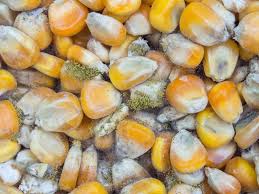By Lydia Gichuki
 With a shortage of maize looming, farmers are turning to test kits to isolate grain that has been contaminated by aflatoxins and help save the remainder of their crops.
With a shortage of maize looming, farmers are turning to test kits to isolate grain that has been contaminated by aflatoxins and help save the remainder of their crops.
The World Health Organisation estimates that about a quarter of all food produced globally is destroyed every year because of aflatoxin contamination. The fungus, which flourishes in damp post-harvest conditions, causes cancer, liver failure and weakened immunity in humans and animals, and Kenya has been found to be the world’s top hotspot for the toxin.
As a result, many Kenyan farmers are now treating their soils with Aflasafe to try and lower the aflatoxins in farms. It is also possible to use fungicides and preservatives to reduce the fungal growth. But the best way to prevent the growth is by drying the maize grain at speed, which is not always possible in Kenya’s sometimes damp conditions, and has been made particularly difficult in recent months by the country’s extended rainy seasons.
Related News:Government intensifies marketing, distribution of Aflasafe to help farmers fight aflatoxin
Earlier this year, the country lost 10,000 hectares of cropland to the high rainfall during the 2019 November short rains, which continued into the harvesting season for maize in January and February, according to the Ministry of Agriculture. More crops were lost as the maize did not have adequate time to dry, causing high levels of aflatoxins.
The kits allow farmers to test for aflatoxin levels in maize on their farms without taking it to government laboratories and private labs. They can also help prevent loss, by equipping farmers to test immediately after harvesting and prevent cross-contamination with maize harvested earlier or later that is uncontaminated.
Related News:Simple indigenous ways to reduce aflatoxin levels in maize meals
Rachel Wangui of FnS Scientific says there are two kits available in Kenya, the Elisa lab for big millers and a test strip format that for farmers in the field. The test strip tests cost Sh5,000 plus VAT and come with a portable reading machine called Raptor, which is an integrated analysis platform, an extraction solvent, ethanol, and 48 strips.
The strip tests provide a far cheaper option for farmers, equating to about Sh900 per test across multiple testing points, compared with a cost of Sh2,500 to Sh3,000 for a single test in a laboratory.
“The number of tests carried out is dependent on the quantity of the maize, because a representative sample must be sampled. For instance, if the maize is stored in a room, a sample must be taken from the four corners in the room, at the centre and from the one hugged, because the levels are heterogeneous. This can be expensive for any farmer to have tests done in a laboratory,” said Wangui.
It also only takes six minutes for the strips to give a result, compared to two or more days when the tests are carried out in a laboratory.
No technical skills are needed to do or interpret the results, with the legal level of aflatoxin in grain set at less than 10 parts per billion (ppb).
Related News:Applying aflasafe chemical two to three weeks ahead of maize flowering stops aflatoxin
To measure the level of aflatoxins, the maize is ground then ethanol is added to extract the aflatoxin and then placed on the strip, which is then placed inside the Raptor machine, which gives a quantitative result, for instance 10ppb, or 20ppb or more.
Aflatoxins tend to contaminate plants that have already been weakened by other factors, such as drought or pests. Therefore, it is important for farmers to know how they can prevent grain loss.
Pre-harvesting, farmers should plant seeds that are resistant to diseases, pests and drought, with preference for seeds that germinate and grow rapidly, and apply Aflasafe two weeks prior to flowering. Crop rotation also helps break pest and disease cycles and improve soil fertility, as do soil additions, such as manure or lime, and timely planting to avoid mid- and late-season drought.
Post-harvesting, farmers should sort out and remove all damaged, mouldy, and shrunken grains. This sorting reduces aflatoxins level by 40 per cent to 80 per cent, and is therefore often critical to saving the rest of the crop.
Related News:Moisture meters tame aflatoxin poisoning in Uganda
The grains should then be dried well, ideally by ensuring they are dried in direct sunlight, covered in the evening and dried on ground that has been cleaned. Farmers need to ensure the moisture of the grain is below 13.5 per cent before storage.
















Comments powered by CComment